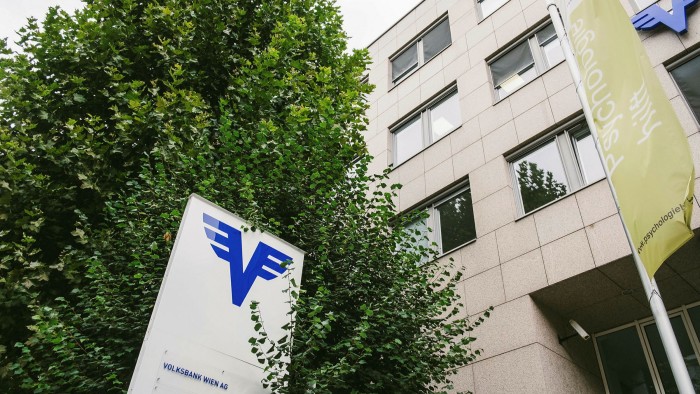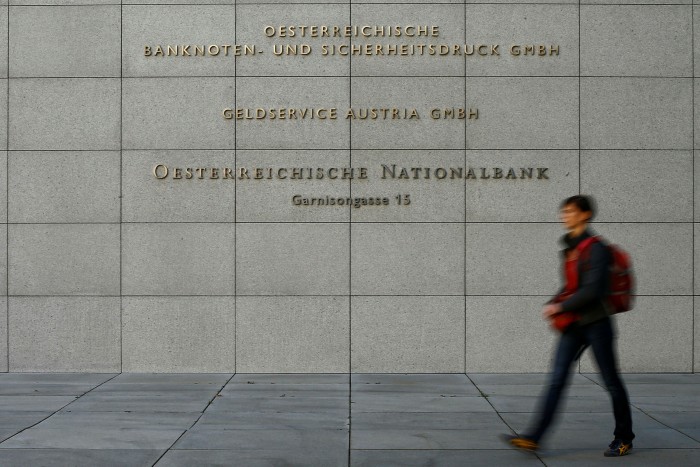Vienna’s finance capital dream edges closer to reality

Roula Khalaf, Editor of the FT, selects her favourite stories in this weekly newsletter.
Austria’s economy has been one of the worst hit in Europe by the coronavirus pandemic. But its financial sector — and, in particular, its banks — are better positioned than most in Europe as social and economic life tentatively returns to normal.
It is a far cry from 2008 and the aftershocks of the global financial crisis, when Austria’s lenders were among the very worst affected, leaving Vienna’s status as a financial centre badly damaged.
Back then, talk of Vienna fashioning itself as the financial capital of central and eastern Europe — a London or a Frankfurt on the Danube — was quickly exposed as hubris. The Austrian government was forced to mount a €100bn bailout scheme. Three of the country’s biggest banks — Hypo Alpe Adria, Kommunalkredit and Österreichische Volksbanken — had to be nationalised and liquidated. Others needed major liquidity support for years after.
But the pandemic may mark a turning point. Analysts and bankers now say that Vienna’s aspirations as a finance hub are matched by reality, as growth in eastern Europe looks set to outpace the EU average, and demand for credit from Austria’s big banks surges.
It is growth that Austrian banks can also afford to finance without overextending their balance sheets. Most of Vienna’s big lenders have spent the aftermath of 2008 building deep capital reserves. Late last year, rating agency Moody’s said Austria’s was one of only six European national banking systems, out of a total of 19, with a stable outlook.
The average Austrian bank’s core tier one capital ratio — a key measure of balance sheet strength — stood at 16.1 per cent at the end of 2020. The EU average was 15.2 per cent.
“Today, Austria’s banks are in a fairly enviable state,” says Máté Nemes, analyst at UBS in Zurich. “In terms of credit losses [from the pandemic], we are talking about only a few dozen basis points, or close to zero.”
Consumer finance demand has returned, mortgage lending is rising and businesses are taking on more debt. “The [banking] sector is benefiting almost on all fronts which I don’t think anyone would have predicted,” says Nemes. “It’s the same across central eastern Europe.”
In 2019, the combined assets of Austrian banks surpassed €1tn for the first time since 2016. That figure has continued to grow despite the Covid crisis, reaching €1.14tn at the end of 2020.
Nearly a quarter of that is lending to central Europe, according to the Österreichische Nationalbank, the central bank. The central and eastern European region’s contribution to banks’ bottom lines is even more notable. In 2019, just over 40 per cent of profits came from lending in central and eastern Europe economies outside Austria. In 2020, the year the pandemic hit, the proportion rose to more than 50 per cent.
There are, nevertheless, structural problems.

Capital markets are still under-developed across the region. Bankers and financiers in Vienna — many with experience of banking in London or New York — bemoan the weakness of markets in Austria and the wider central and eastern European region.
Most companies, even the very largest, take on debt in the form of direct loans from lenders — typically banks and credit institutions that they have deep and historic relationships with. That makes them less nimble. And it means banks and financiers in Austria have fewer opportunities to earn fees through advice on accessing capital markets or helping to structure fundraisings.
The flipside is financial conservatism in households. Austria has a household indebtedness equivalent to just over 50 per cent of gross domestic product, compared to an EU average of 65 per cent. Savings rates are extremely high. But consumers still prefer to sit on cash, rather than invest in funds or markets, which they still view with scepticism.
One senior Viennese banker laments the financial illiteracy of many of his fellow Austrians. Across the region, there is a tendency to see any kind of market investing — even relatively basic investing in blue-chip equities — as dabbling in “speculation, or turbocharged Anglo-Saxon capitalism”.
Many banks are working to change such mindsets. Through digitisation, they are making financial trading and investing in funds easier.
Another challenge to Vienna’s financial development is the push across the western banking sector into sustainable finance. The biggest banks such as Erste Group, Raiffeisen Banking Group and UniCredit Bank Austria have all pledged to green their balance sheets — Erste, for example, has said it will exit all coal investments by 2030. But that is a significant worry for institutions with substantial corporate relationships in eastern Europe, where dirty energy and heavy manufacturing are still widespread — and highly profitable.
Political risks, too, still loom large for the sector. Well-capitalised banks have, in recent years, been an attractive potential source of funding for cash-strapped governments. Even before the pandemic struck, Czech prime minister Andrej Babis, for example, suggested a new levy on bank dividends to bolster state coffers. Erste Group’s rancorous relationship with the government of Hungary’s prime minister Viktor Orban has been a longstanding financial drag.
Of more immediate concern, the political crisis in Belarus and imposition of EU sanctions represents a hard-to-quantify but serious risk to Austria’s finance sector. Raiffeisen is one of the biggest foreign lenders in the country. As such, the bank is vulnerable to decisions from both Minsk and Brussels as the two sides seek ways to press each other into backing down. Such risks are echoed in Ukraine and Russia, where Austrian financiers also have a significant presence.
The prospects for Vienna as a financial centre are the best they have been in nearly two decades. But the world — facing urgent challenges ranging from climate disaster to growing geopolitical instability — is also a far more uncertain place.

Comments